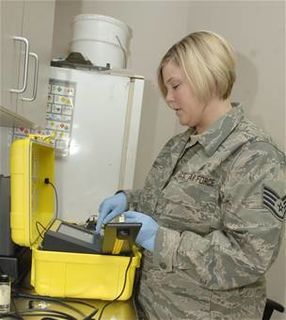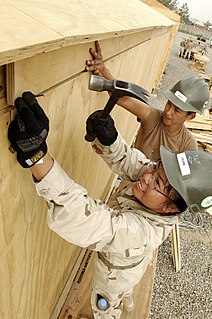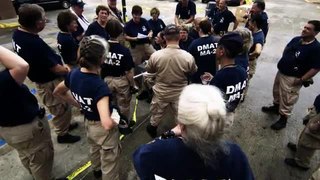
Isocyanate is the functional group with the formula R−N=C=O. Organic compounds that contain an isocyanate group are referred to as isocyanates. An organic compound with two isocyanate groups is known as a diisocyanate. Diisocyanates are manufactured for the production of polyurethanes, a class of polymers.

Personal protective equipment (PPE) is protective clothing, helmets, goggles, or other garments or equipment designed to protect the wearer's body from injury or infection. The hazards addressed by protective equipment include physical, electrical, heat, chemicals, biohazards, and airborne particulate matter. Protective equipment may be worn for job-related occupational safety and health purposes, as well as for sports and other recreational activities. "Protective clothing" is applied to traditional categories of clothing, and "protective gear" applies to items such as pads, guards, shields, or masks, and others. PPE suits can be similar in appearance to a cleanroom suit.

A firefighter is a rescuer extensively trained in firefighting, primarily to extinguish hazardous fires that threaten life, property, and the environment as well as to rescue people and in some cases or jurisdictions also animals from dangerous situations. Male firefighters are sometimes referred to colloquially by the historical term fireman although the use of this terminology is officially discouraged.
Broadly speaking, a risk assessment is the combined effort of:
- identifying and analyzing potential (future) events that may negatively impact individuals, assets, and/or the environment ; and
- making judgments "on the tolerability of the risk on the basis of a risk analysis" while considering influencing factors.
The Occupational Safety and Health Administration is a large regulatory agency of the United States Department of Labor that originally had federal visitorial powers to inspect and examine workplaces. Congress established the agency under the Occupational Safety and Health Act, which President Richard M. Nixon signed into law on December 29, 1970. OSHA's mission is to "assure safe and healthy working conditions for working men and women by setting and enforcing standards and by providing training, outreach, education and assistance". The agency is also charged with enforcing a variety of whistleblower statutes and regulations. OSHA is currently headed by Acting Assistant Secretary of Labor Loren Sweatt. OSHA's workplace safety inspections have been shown to reduce injury rates and injury costs without adverse effects to employment, sales, credit ratings, or firm survival.

Occupational hygiene is the anticipation, recognition, evaluation, control, and confirmation of protection from hazards at work that may result in injury, illness, or affect the well being of workers. These hazards or stressors are typically divided into the categories biological, chemical, physical, ergonomic and psychosocial. The risk of a health effect from a given stressor is a function of the hazard multiplied by the exposure to the individual or group. For chemicals, the hazard can be understood by the dose response profile most often based on toxicological studies or models. Occupational hygienists work closely with toxicologists for understanding chemical hazards, physicists for physical hazards, and physicians and microbiologists for biological hazards Environmental and occupational hygienists are considered experts in exposure science and exposure risk management. Depending on an individual's type of job, a hygienist will apply their exposure science expertise for the protection of workers, consumers and/or communities.

Emergency management is the organization and management of the resources and responsibilities for dealing with all humanitarian aspects of emergencies. The aim is to reduce the harmful effects of all hazards, including disasters.
Hazardous Waste Operations and Emergency Response is a set of guidelines produced and maintained by the Occupational Safety and Health Administration which regulates hazardous waste operations and emergency services in the United States and its territories. With these guidelines, the U.S. government regulates hazardous wastes and dangerous goods from inception to disposal.

An occupational hazard is a hazard experienced in the workplace. Occupational hazards can encompass many types of hazards, including chemical hazards, biological hazards (biohazards), psychosocial hazards, and physical hazards. In the United States, the National Institute for Occupational Safety and Health (NIOSH) conduct workplace investigations and research addressing workplace health and safety hazards resulting in guidelines. The Occupational Safety and Health Administration (OSHA) establishes enforceable standards to prevent workplace injuries and illnesses. In the EU a similar role is taken by EU-OSHA.
"Right to know", in the context of United States workplace and community environmental law, is the legal principle that the individual has the right to know the chemicals to which they may be exposed in their daily living. It is embodied in federal law in the United States as well as in local laws in several states. "Right to Know" laws take two forms: Community Right to Know and Workplace Right to Know. Each grants certain rights to those groups. The "right to know" concept is included in Rachel Carson's book Silent Spring.

The Health Hazard Evaluation (HHE) program is a workplace health program administered by the National Institute for Occupational Safety and Health (NIOSH). NIOSH developed the HHE program to comply with a mandate in the Occupational Safety and Health Act of 1970 to investigate workplace health hazards reported by employers and employees. According to Section 20(a)(6) of the Act, the Secretary of Health and Human Services is authorized "following a written request by any employer or authorized representative of employees, to determine whether any substance normally found in the place of employment has potentially toxic effects in such concentrations as used or found."

Bioenvironmental Engineering is a process of using engineering principles to reduce and solve environmental health risks and dangers caused by human activity It may comprise four general areas of work : radiation, industrial hygiene, environmental protection and emergency response.
Workplace health surveillance or occupational health surveillance (U.S.) is the ongoing systematic collection, analysis, and dissemination of exposure and health data on groups of workers. The Joint ILO/WHO Committee on Occupational Health at its 12th Session in 1995 defined an occupational health surveillance system as “a system which includes a functional capacity for data collection, analysis and dissemination linked to occupational health programmes”.

Public safety diving is underwater diving conducted as part of law enforcement and search and rescue. Public safety divers differ from recreational, scientific and commercial divers who can generally plan the date, time, and location of a dive, and dive only if the conditions are conducive to the task. Public safety divers respond to emergencies 24 hours a day, 7 days a week, and may be required to dive in the middle of the night, during inclement weather, in zero visibility "black water," or in waters polluted by chemicals and biohazards.

A physical hazard is an agent, factor or circumstance that can cause harm with contact. They can be classified as type of occupational hazard or environmental hazard. Physical hazards include ergonomic hazards, radiation, heat and cold stress, vibration hazards, and noise hazards. Engineering controls are often used to mitigate physical hazards.
A hazard is a potential source of harm. Substances, events, or circumstances can constitute hazards when their nature would allow them, even just theoretically, to cause damage to health, life, property, or any other interest of value. The probability of that harm being realized in a specific incident, combined with the magnitude of potential harm, make up its risk, a term often used synonymously in colloquial speech.

Occupational safety and health (OSH), also commonly referred to as occupational health and safety (OHS), occupational health, or occupational safety, is a multidisciplinary field concerned with the safety, health, and welfare of people at occupation. These terms also refer to the goals of this field, so their use in the sense of this article was originally an abbreviation of occupational safety and health program/department etc.

Emergency Responder Health Monitoring and Surveillance (ERHMS) is a health monitoring and surveillance framework developed by a consortium of federal agencies, state health departments, and volunteer responder groups designed to address existing gaps in surveillance and health monitoring of emergency responders. The framework provides recommendations, guidelines, tools, and trainings to protect emergency responders during each phase of an emergency response, including pre-deployment, deployment, and post-deployment phases. ERHMS was designed to function within the Federal Emergency Management Agency's (FEMA's) National Incident Management System (NIMS), a systematic approach to emergency management. The ERHMS trainings satisfy Public Health Emergency Preparedness capability 14, "Responder Safety and Health."
Engineering controls are strategies designed to protect workers from hazardous conditions by placing a barrier between the worker and the hazard or by removing a hazardous substance through air ventilation. Engineering controls involve a physical change to the workplace itself, rather than relying on workers' behavior or requiring workers to wear protective clothing.
Occupational hazards of fire debris cleanup are the hazards to health and safety of the personnel tasked with clearing the area of debris and combustion products after a conflagration. Once extinguished, fire debris cleanup poses several safety and health risks for workers. Employers responsible for fire debris cleanup and other work in areas damaged or destroyed by fire are generally obliged by occupational safety and health legislation of the relevant national or regional authority to identify and evaluate hazards, correct any unsafe or unhealthy conditions and provide any necessary training and instruction and personal protective equipment to employees to enable them to carry out the task without undue exposure to hazards. Many of the approaches to control risk in occupational settings can be applied to preventing injuries and disease. This type of work can be completed by general construction firms who may not be fully trained specifically for fire safety and on fire hazards.













